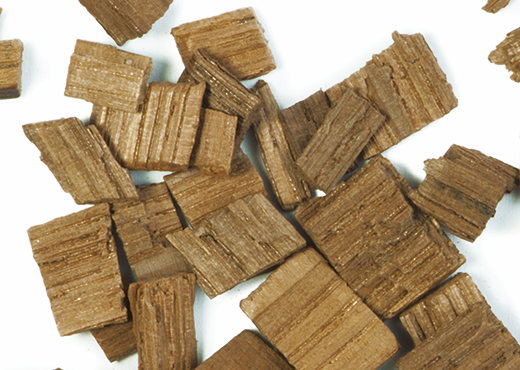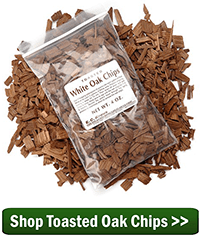 Howdy Ed,
Howdy Ed,
…To balance the tannins, we French oak chipped the must at the start of fermentation [Petite Sirah] and at the half way point applied the Aussie method of Rack and Return to decrease the seeds in the must. Sieving out the seeds also removed the oak chips. My question is, at what stage should we re-oak the juice?
Jamie O. — CA
—–
Hello Jamie,
I would not automatically assume that you will need to add more oak chips to your homemade wine. In fact, I would not consider adding more French toasted oak chips to the wine until it has cleared and maturated to some degree while in bulk. See what tannins and other proteins drop out on their own, first.
There is nothing wrong with adding toasted oak chips during the fermentation, but you want to use a moderate dosage. Don’t go to overboard. It is possible to add to much. If you want to add oak to the wine during the fermentation, you may also want to consider using oak powder instead of oak chips. Oak powder does not strain out like the oak chips. Having said that, I do prefer using toasted oak chips after the fermentation.
If it is only protein stability that you are concerned about, you also have the option of treating the wine with bentonite, instead of more oak chips. Among other things, bentonite will collect and drop out excessive tannins. This will help to make the wine more heat stable while aging in bottles.
If it is the flavor effects of toasted oak chips you are primarily looking for, it would be best to wait until the wine has aged in bulk for a month or so after the fermentation has completed. This is when I would add oak chips to your homemade wine. I don’t know how many gallons you have, but you can store it in carboys or vats. At this point, you want the wine to be off any yeast sediment and the head-space should be eliminated, as well.
 Buy waiting you are allowing the wine to get to a point where you can start to distinguish its developing flavor profile. Adding oak chips at this point will not only help you to stabilize the wine further, it will allow you to monitor the oak balance of the wine. Since the wine is already maturating, you can do this with a little clearer perception of the final outcome.
Buy waiting you are allowing the wine to get to a point where you can start to distinguish its developing flavor profile. Adding oak chips at this point will not only help you to stabilize the wine further, it will allow you to monitor the oak balance of the wine. Since the wine is already maturating, you can do this with a little clearer perception of the final outcome.
Monitor the wine by sampling along the way. Depending on the dosage you will want to sample every 1 to 4 weeks.
I recommend 1/4 pound of toasted oak chips for every 10 gallons of wine. At this dosage a typical amount of time for oaking is about 30 to 90 days. Sample the wine every 2 weeks. Here is some more information on how much and how long to use oak chips.
What you are looking for is balance. You want the reduced harshness of oak aging to be in line with woody character the oak is adding.
Best Wishes,
Customer Service at E. C. Kraus
—–
Ed Kraus is a 3rd generation home brewer/winemaker and has been an owner of E. C. Kraus since 1999. He has been helping individuals make better wine and beer for over 25 years.

My Red Zin has matured for over 2 months. Can I add oak chips AND Chitosan or Superkleer together? Or, must I add them separately? Joe B.
Joseph, I would probably add the fining agents first and after the wine is clear add the oak chips.
Hellow! I am Glory……what fining agents you always used in your wine? Help plz.
Glory, the article posted below discusses the different types of fining agents and what they do to help you pick the best one for your needs.
Fining Agents
https://eckraus.com/wine-making-finings/
do you need to boil the chips or sanitize with star-san solution?
Steve, the direction for our oak chips state to prepare the oak chips before using by boiling in water for 15 minutes. Strain the chips off the water and then add the them directly to the wine. You do not want to use star-san on the chips.
I added oak chips to my Cab Saug batch on 11/21. I have been tasting periodically and today 1/6 I decided to rack my wine to remove the chips. I like the flavor. When I opened my square car boy vat, there was a “blotching skin” covering the entire surface. I have never seen this before. Is a normal response after wood chips?
Mimi, without being there to see what is occurring, it is possible that the wine is starting to develop bacteria on the surface. This can happen if there is too much head-space, improper sanitation or you did not add sulfites before aging the wine. If this is what is happening with your wine, the article below will advise you how to treat the wine.
Scum On Top Of wine
https://blog.eckraus.com/white-scum-on-top-of-homemade-wine
When I added the oak chips to the carboy after fermentation was completed….I failed to “treat” the oak chips first. I left the chips in for about 30 days before I racked into a second carboy. This past weekend I bottled the wine. By my failure to treat the wood chips before adding them to the wine what damage may I have caused to the wine itself and is there any “risks” in drinking the wine after it has aged in the bottle?
Rich, the purpose of treating the oak chips by boiling for example is to sanitize the oak chips before adding them to the wine. There really is no way for us to tell if how or even if this will effect the flavor of your wine. If you plan to add sulfites when you bottle the wine it will help keep the wine from spoiling and should destroy anything bad in the wine.